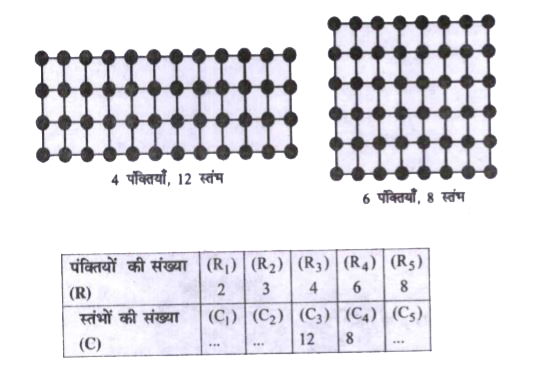Take a squared paper and arrange 48 counters on it in different number of rows as shown below :

What do you observe ? As R increase, C derecases.
(i) Is R1:R2=C2:C1 ? (ii) Is R3:R4=C4:C3?
(iIi) Are R and C inversely proportional to each other ? Solution in Punjabi
Step by step video & image solution for Take a squared paper and arrange 48 counters on it in different number of rows as shown below : What do you observe ? As R increase, C derecases. (i) Is R_(1):R_(2)=C_(2):C_(1) ? (ii) Is R_(3):R_(4)=C_(4):C_(3)? (iIi) Are R and C inversely proportional to each other ? by Maths experts to help you in doubts & scoring excellent marks in Class 8 exams.
Updated on:21/07/2023Similar Questions
If A=[1 2−13−2 5] , then R1↔R2 and C1→C1+2C3 given
View Solutionएक वर्गांकित कागज लीजिए और उस पर 48 काउंटरों (counters) को पंक्तियों की विभिन्न संख्याओं में नीचे दर्शाए अनुसार व्यवस्थित कीजिए :

यहाँ जब R में वृद्धि होती है, तो C में कमी होती है।
अब निम्नलिखित प्रश्नों का उत्तर दें :-
(i) क्या R1:R2=C2:C1 है ?
(ii) क्या R3:R4=C4:C3 है ?
(iii) क्या R और C परस्पर व्युत्क्रमानुपाती हैं ?
View SolutionProve the questions
a(rr1+r2r3)=b(rr2+r3r1)=c(rr3+r1r2)
View Solutionthree circles C_(1),C_(2) And C_(3) whose radii r_(1),r_(2) And r_(3) is Where r_(1)ltr_(2)ltr_(3) ) is shown in the given figure. r_(2) What is the value of
View SolutionComparison of C_(3) and C_(4) plants:- ltimg src="https://d10lpgp6xz60nq.cloudfront.net/physics_images/ALN_BIO_XI_C11_E01_052_Q01.png" width="80%"gt
View SolutionThree circles C_(1),C_(2),C_(3) with radii r_(1),r_(2),r_(3)(r_(1)ltr_(2)ltr_(3)) respectively are given as r_(1)=2 , and r_(3)=8 they are placed such that C_(2) lines to the right of C_(1) and touches it externally C_(3) lies ot the right of C_(2) and touches it externally. There exist two stratight lines each of whic is a direct common tangent simultaneously to all the three circles then r_(2) is equal to
View SolutionTake a squared paper and arrange 48 squares in different number of rows as shown below: What do you observe? As R increases, C decreases Is R_(1) : R_(2) = C_(2) : C_(1) ?
View SolutionTake a squared paper and arrange 48 squares in different number of rows as shown below: What do you observe? As R increases, C decreases Is R_(3) : R_(4) = C_(4) : C_(3) ?
View Solution
